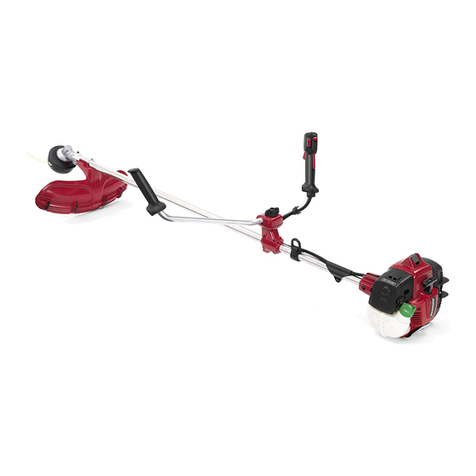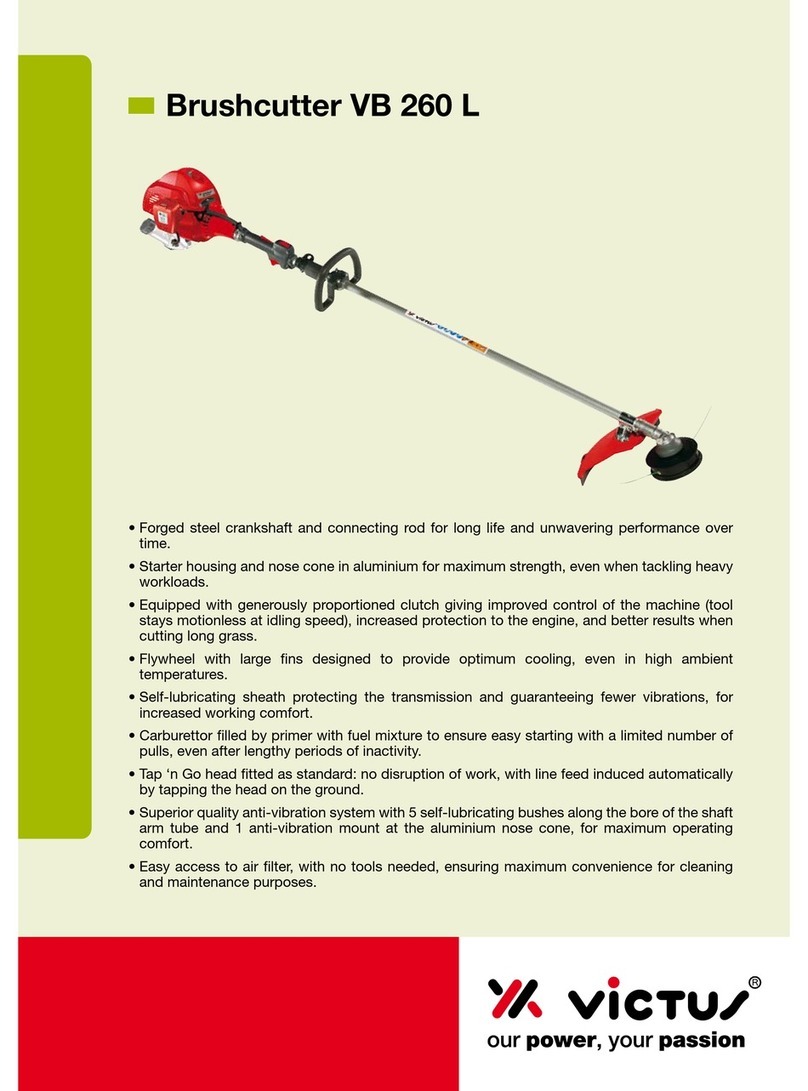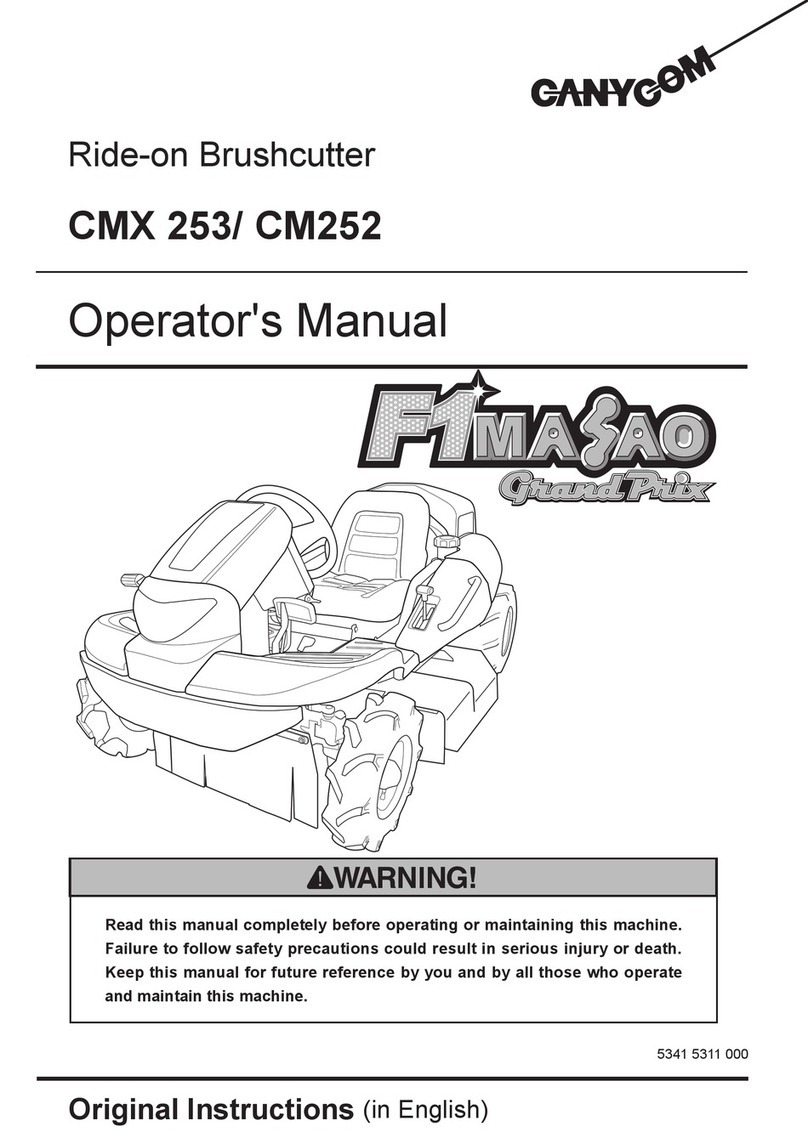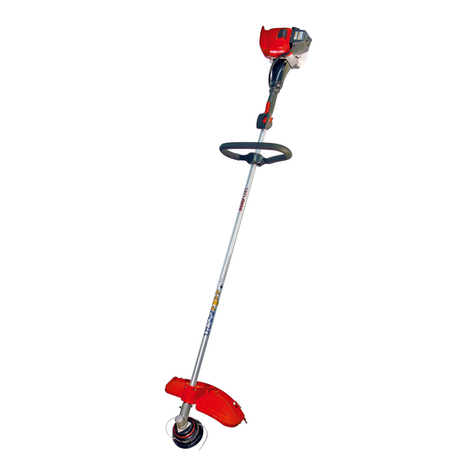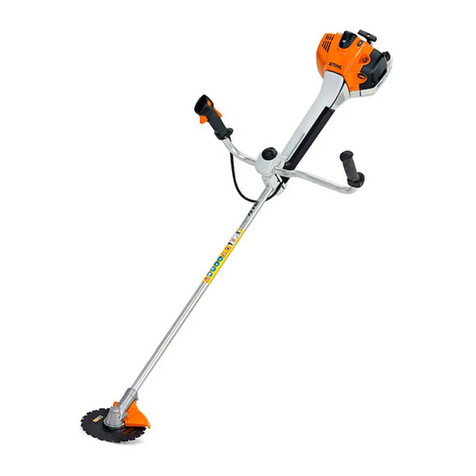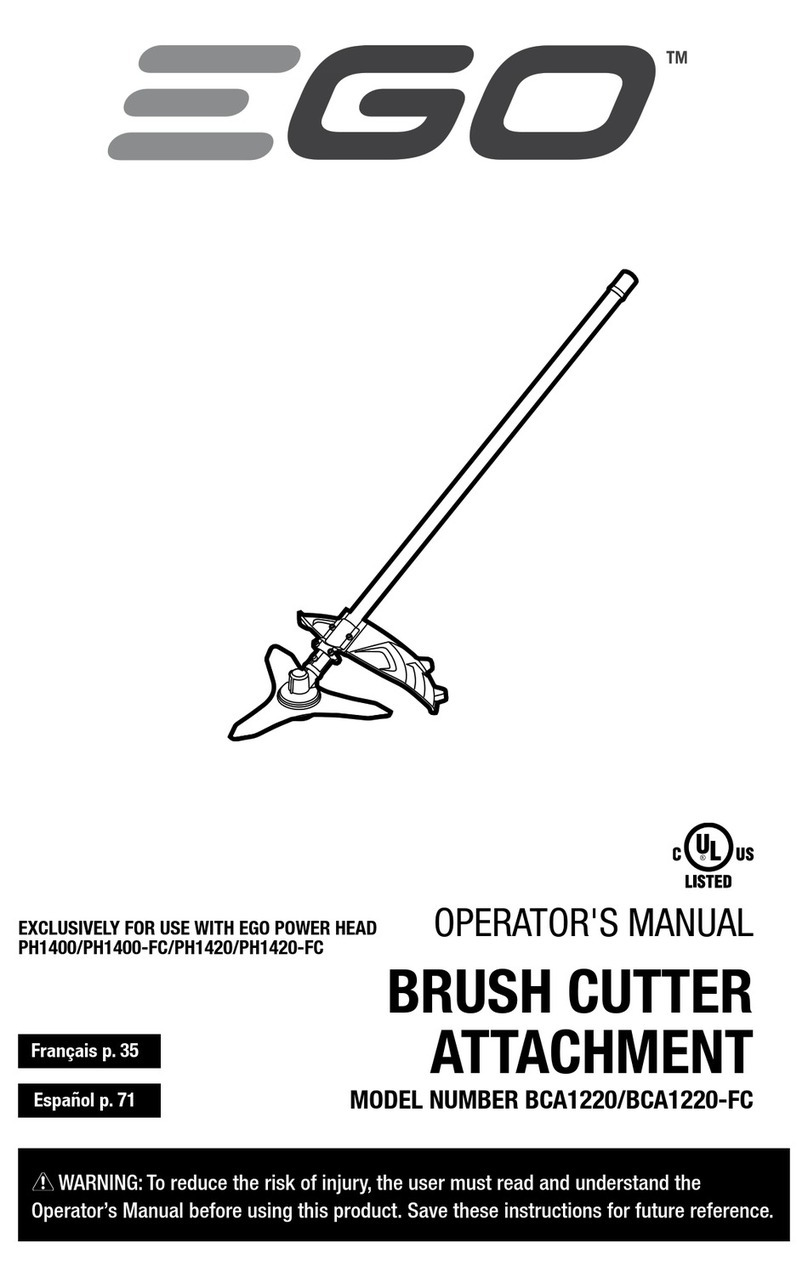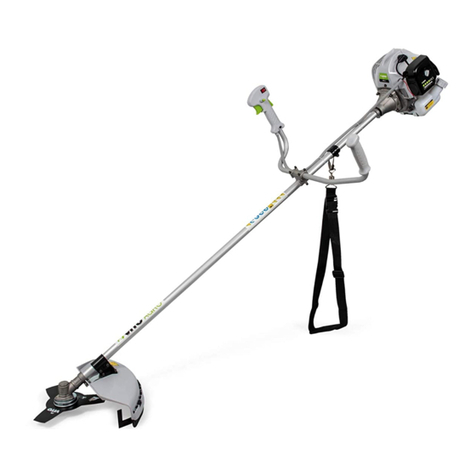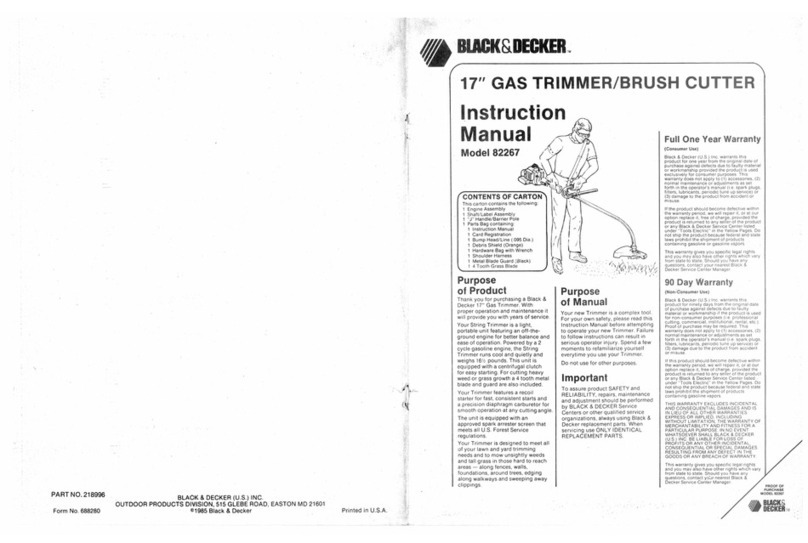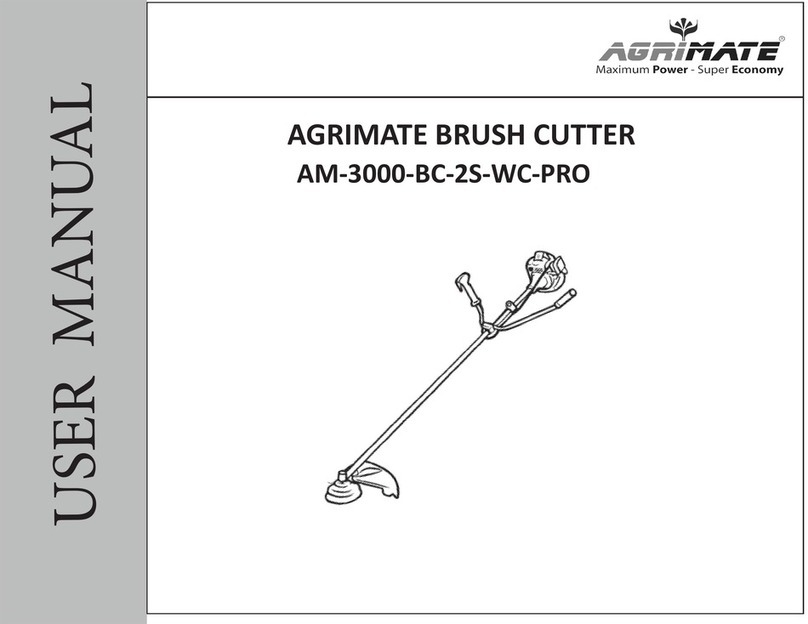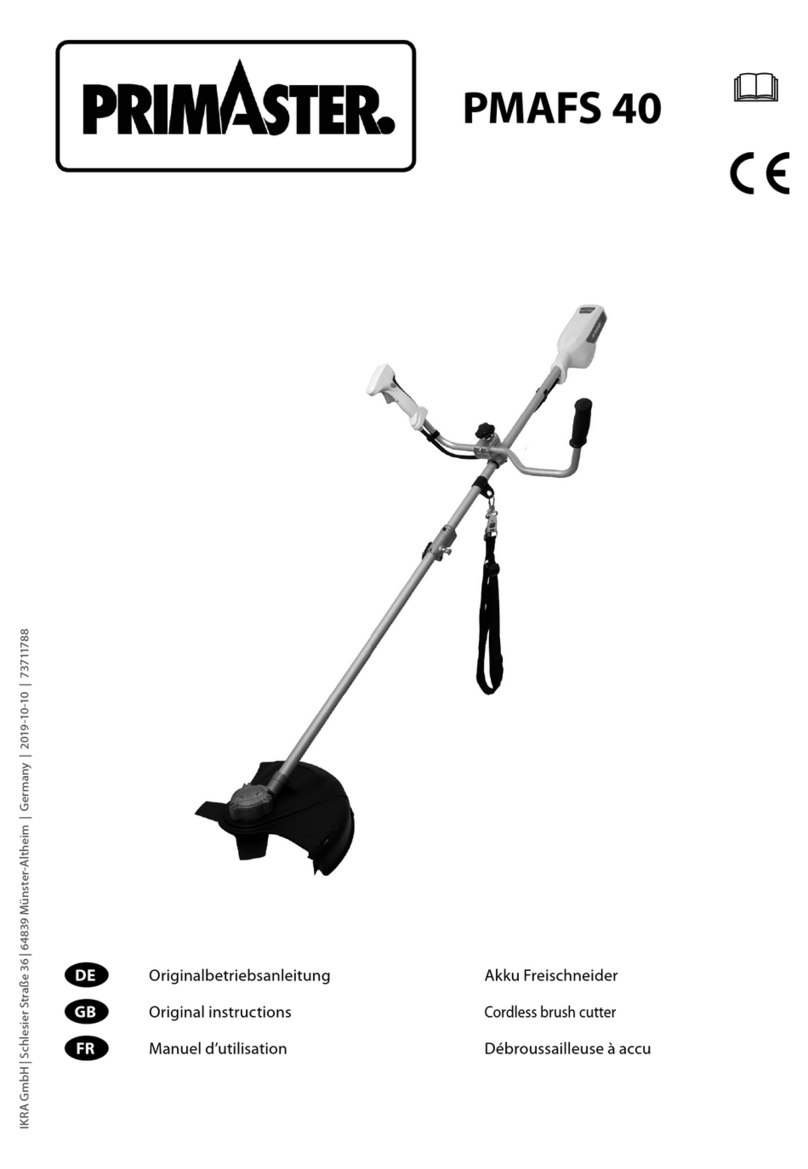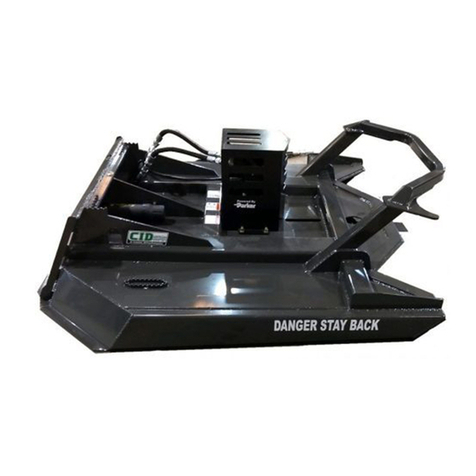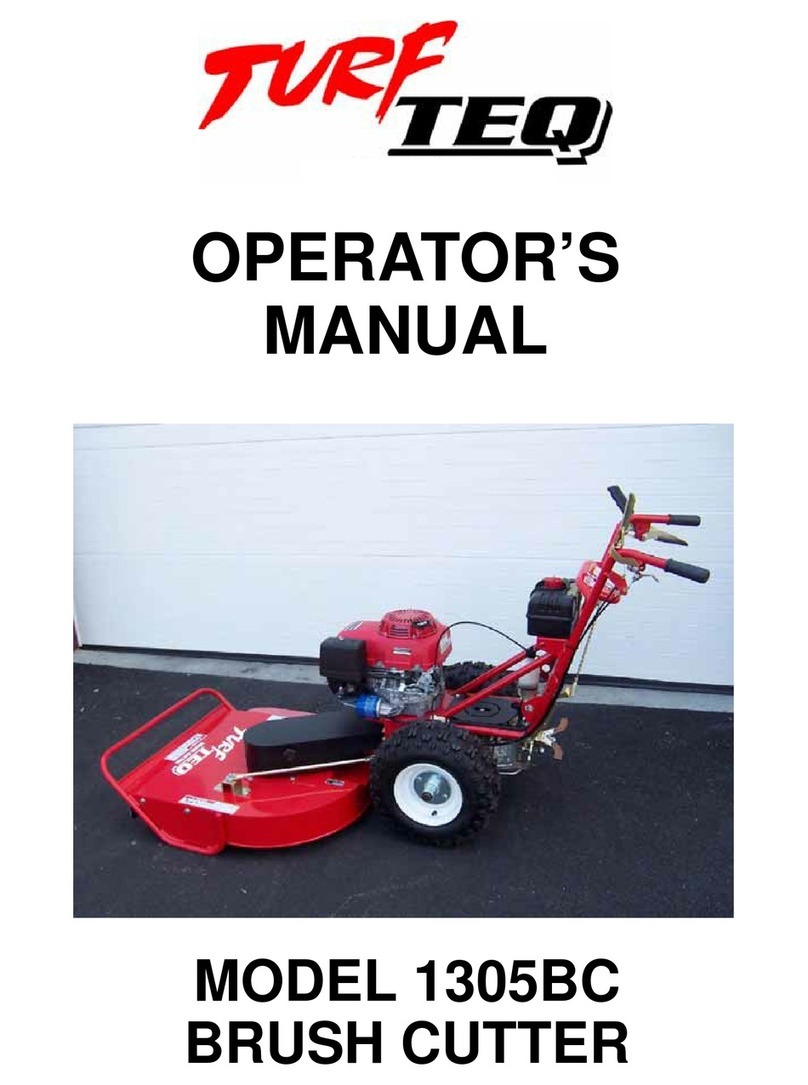Goodyear GY 33SBC User manual

GY 52BC
GY 52BCA





7
18
31
43
55
68

English Operating manual
7
C ontents
For your safety . . . . .. . .. . . .. . 8
Operating and display
elements . .. . .. . . .. . .. . . .. 11
Installation manual . . . . . . . . . . 11
Oil and petrol . .. . . .. . .. . . .. 13
Operation . .. . .. . . .. . .. . . .. 13
Maintenance and cleaning . . . . 15
Transportation . . . . .. . .. . . .. 17
Warranty . .. . .. . . .. . .. . . .. 17
Troubleshooting . . . . . . . . . . . . 17
Information on the
identification plate
Enter all the detailson your
mower’s rating plate in the follo-
wing elds. You will nd the identi-
cation plate in the vicinity of the
engine.
Thes e details are very important as
they will not only be needed for
identifying your machine when
orde-ring replacement parts but
they will also be required by
Customer Ser-vice.
These and other details for your
appliance can be found on the
separate CE declaration of confor -
mity that forms an integral part of
these operating instructions.
Illustrations
Fold out the illustrated pages at the
start of the operating manual.
Graphical representations can vary
in detail from the appliance which
has been bought.
For your safety
Use the machine properly
This appliance is approved s olely
for use
– for private use
– fortrimminglawnedgesandsmall
inaccessible areas of grass (e.g.
under bushes),
– for cuttingwild growth, shrubs and
undergrowth,
–in accordance with the
descriptions andsafety
instructions specied in this user's
guide,
Any other use is not an intended
use. Improper use is not covered
by the warranty and the manufactu-
rer will reject any liability. The user
is liable for all injuries to third par-
ties and damage to their property.
Operate the m achineonly in the
technical conditi on in which it has
been provided and delivered by the
manufacturer.
Unauthorised changes to the
achineex clude liability of the
manufacturer for any resulting
damage and/or injury.
R ead all instructions before
operating
Please read these instructions
carefully. Famil iarize yourself
with the operation and handling
of the unit.
Do not use this unit if you are
tired or ill or under the inuence
of alcohol, drugs or medication.
Do not permit children under the
age of 16 to handle this machine
(local regulations may specify the
minimum age of the user).
This m achine is not intended for
use bypersons (including
children) with r educed physical,
sens ory or mental capabilities, or
lack of experience and
knowledge, unless theyhave
been given supervision or
instruction concerning use of the
machineby a person
responsible for their safety.
Children should be supervise d to
ensur e that they do not play with
the appliance.
Checkthe unit before using it.
Replace damagedparts.
Check whether fuel is running
out. Ensure that all connections
are attached and tight. Replace
cutting attachment parts which
are cracked, awed or damaged
in any other way. Ensure that the
cutting attachment has been
installed correctly and attached
securely. Ensure that the guard
for the cutting a ttachment has
been attached correctly and is in
the recommended position. If
these instructions are not
followed, the user and on-lookers
may be injured andthe power
tool damaged.
Use only original replacement
lines which have a diameter of
max. 3.0 mm. Never use a metal-
reinforced string, wire, chain,
rope, etc.. These may break o
and become dangerous
projectiles.
Always be aware of the risk of
injury to head, hands and feet.
Depress the thro ttle. It must
automatically return to the home
position. Perform all settings and/
or repairs before operating the
unit.
Always wear protective gloves
when working on the cutting
attachment to prevent injuries
caused by sharp edges or
blades.
Before using the unit, always
clear the area which you want to
trim. Remove all objects such as
stones, broken glass, nails, wire
or string which could be ejected
or become entangled in the
cutting attachment. Remove
children, bystanders and animals
from the area. Keep children,
bystanders and animals at a
minimum distance of 15 m; there
is always a risk of bystanders
being hit by ejected objects.
Bystanders should wear eye
protection. If somebody
approaches, immediately switch
o the engine and cutting
attachment.

Operating manualEnglish
8
R aynaud’s disease
(vibration white finger)
The frequent use of vibrating
power tools may damage nerves
in people whose blood circulation
is impaired (e.g. smokers,
diabetics). In par ticular, ngers,
hands, wrists and/or arms may
show some of the following
symptoms:Pain, tingling,
stabbing, numbness of body
parts, skin turning pale.
If you notice unusual
impairments, stop working
immediately and consult a
doctor. You can signicantly
reduce the ri sks by following
these instructions:
Keep your body, and in particular
your hands, warm in cold
weather. Working with
undercooled hands is the main
contributing factor!
Take regular bre aks and move
your hands. This willstimulate
your blood circulation.
S afety instructions for petrol-
driven power tools
Petrol is highly ammable and the
vapours may explode when ignited.
Take the following precautions:
Store petrol only in containers
which are specially designated
and authorisedforthis purpose.
Ensure that spilled petrol cannot
be ignited. Do not start the
engine until the petrol vapours
have evaporated.
Before refuelling, always switch
o the engine and leave it to cool
down. Never remove the tank
cap or ll the tank while the
engine is hot. Never use the
power tool without screwing on
the tank cap tig ht. Unscrewthe
tank cap slowly to reduce
pressure in the tank slowly.
Mix and add petrol in a clean,
well ventilated area outdoors
where there are no sparks or
ames. Unscrew the tank cap
slowly when you have switched
the engine o. Do not smoke
while mixing or topping up petrol.
Immediately wipe spilled petrol
o the power tool.
Move the power tool at least 10
m from thelling station before
starting the engine. Do not
smoke andkeep sparks and
naked ames away from the area
while you aretopping upthe
petrol or using the power tool.
Replace a damaged exhaust,
tank or tank cap.
Operating the unit
Never start t he power tool and
never leave it running if you are
in an enclosed room or building.
The inhalation of exhaust gases
may be fatal. Use the power tool
outdoors only.
Wear eye and ear protection
when using the unit. If working in
a dusty environment, wear a face
or dust mask. A long-sleeved
shirt is recommended. Working
without eye or ear protection may
result in severe e ye injuries or
loss of hearing.
Wear thick, longtrousers, boots
(anti-skid) and gloves. Do not
wear loose clothing, jewellery,
short trousers, sandals anddo
not walk barefoot. Pin your hair
above your shoulders. If
required, wear a hair net.
The cutting attachment cover
must always be attached when
you use the unit as a lawn
trimmer. Both trim lines must be
pulled out and the correct line
must be installed. The trim line
must not be pulled out over the
end of the cover.
The unit has a clutch. The cutting
attachment stops whenthe unit is
running at no load. If it does not
stop, have the unit adjusted by a
mechanic at your authorised
dealer.
Before switchin g on the unit,
ensure that the line spool/cutting
blade cannot strike an object.
Adjust the handle bar to your
height so that the you have the
unit under control.
Operate the unit in daylight or
adequate articial lighting only.
Avoid starting t he power tool by
accident. Be ready to operate the
unit when you pull the starter
rope. User and p ower tool must
be in a stable position before the
power tool is started. Follow the
Start/Stop instructions.
Use this unit for its designated
purpose only.
Do not stretch too far over the
unit. Always have a secure
footing and keepyour balance.
When operating the unit, always
hold the unit rmly with both
hands. Always hold both sides of
the handle bar rmly.
When operating the unit, always
wear the shoulder belt.
Do not use the unit in adverse
weather conditions, e.g. if there
is a risk of rain or a storm.
Never change the pre-set factory
engine settings.
Work in alternative working
positions andpunctually
schedule resting periods to
prevent tiredness and
exhaustion.
Avoid open re, formation of
sparks, and do not smoke.
Never operate the unit with a
defective ignit ion switch.
Keepyour hands, face and feet
away from all moving parts. Do
not touch the cut ting attachment
while it is rotating and do not
attempt to stop it.
Do not take hold of the engine or
silencer. These become very hot
during use. They remain hot for a
short time even whenthe power
tool has been switched o.
Do not let the engine run quicker
than required for cutting or
trimming of lawn edges. Do not
run the engine at high speed
when it is not cutting.

English Operating manual
9
Always switch o the engine if
you cannot start cutting
immediately or if you are moving
from one placeto another.
If unusual vibrations occur,
switch o the engine
immediately. Check the unit for
damage. If the unit is damaged,
contact a specialist company.
If you strike or ensnare a foreign
object, immediately switch o the
engine and check whether the
unit has been damaged. Never
use the unit wit h loose or
damaged parts.
Before removing blockages or
performing other work on the
unit, switch o the engine and
remove the spark-plug terminal.
Stop and switch the engine o
before performing maintenance
or repairs or before changing
cutting attachments. Also pull out
the spark-plug terminal.
Use only original spare parts for
repairs. These parts can be
purchased from your authorised
dealer.
Never use parts, accessories or
attachments which are not
authorised for this unit.
Otherwise, theuser may be
seriously injured and the unit
damaged. In addition, your
warranty may be deemed null
andvoid.
Keepthe unit c lean and ensure
that there are no plants or other
objects caught betweenthe
cutting attachment and guard.
To reduce the risk of re, please
replace damaged muers and
spark extinguishers andremove
grass, leaves, excess lubricants
and layers of soot from the
engine and muer.
Have all repairs carried out by a
repair shop only.
Working with the cutting
blade (depending on model)
Before operating the unit, please
read all safety instructions
carefully.
Always keepthehandle bar
between the user and cutting
attachment.
Never cut material if the cutting
blade is 75 cm or higher above
ground level.
The unit may recoil if the rotating
blade strikes an object which
cannot be cut immediately.
Recoils may be strong enough to
throw the unit and/or user in any
direction and may cause the user
to lose control of the unit. Recoils
may occur without warning if the
blade gets caught, jams or locks.
This can easily happen in areas
in which the material to be cut is
dicult to see.
Never use the undergrowth blade
to cut undergrowth thicker than
12.7 mm. Otherwise, violent
recoils may occur.
When using the cuttingblade,the
cutting attachment cover must
always be attached.
Do notattempt to touch or stop
the blade while it is rotating.
A rotating blade may cause
injuries, even when the engine
has been switched o or the
throttle has beenreleased. Hold
the unit rmly until the blade has
come to a standstill.
Do not run the engine at high
speed whenit is not cutting.
If you strike or ensnare a foreign
object, immediately switch o the
engine and check whether the
unit has been damaged. Have
the repair damaged before
continuing to use the unit. Do not
use the unit with a bent, cracked
or blunt blade. Throw away bent,
twisted, cracked or broken
blades.
Do not sharpen the cutting blade.
The sharpened tip of the blade
may break o during operation.
This may result inserious
injuries. Replace the blade.
After operating the unit
Clean the cutting blades with a
household deterge nt to remove
any remnants. Lubricate the
blade with machine oil to prevent
rust.
Store and lock away the blade
securely to protect it from
damage and unauthorised use.
Attachthe guard for the cutting
blade after every instance of use,
as well as during transport and
storage.
Other safety instructions
As long as the tank still has petrol
in it, never store the unit in a
building where vapours could
come into contact with sparks or
naked ames.
Leave the engine tocool down
before transporting or conveying
the unit. Attach the unit securely
for transportation.
Empty the fuel tank before
transporting themachine.
Store the unit in a dry condition,
locked away or high up to
prevent unauthor ised use and
damage. Keep th e power tool
away from children.
Never sprinkle or spray the
power tool with water or other
liquids. Keep the handle bar dry,
clean and dust-free. After use,
always clean the power tool;
follow the instructions for
cleaning and storage.
Dispose of waste petrol/oil and
waste packaging accordingto
local regulations.
Keepthis manual. Readit
frequently and use it to instruct
other users. If you lendthis unit
to somebody else, also include
this manual.
Operating times
Comp ly with the national/municipal
regulations concerning the times
when the machine may be used
(if required, contact your local
authority).
S ymbols on the machine
This operating manual descr ibes
safety and international s ymbols
and pictograms which may be dis-
played on this unit. Read this user
handbook in order tofamiliarise
yourse lf with all safety, installation,
operating and repair instructions .

Operating manualEnglish
10
Caution!
Before starting up the
appliance, read the
operating instructions!
Weareye,hearingand
head protection.
While operating this
device, wear non-slip
boots and protective
gloves.
Keep third parties
away from the danger
area!
Ejected objects and
rotating parts may
cause serious injuries!
Risk of injuryfrom
rotating parts!
Keep hands and feet
away from rotating
parts.
Beware of hot sur
-
faces!
Keep re away from
the fuel tank!
Petrol/Oil
Always use a clean
and fresh unleaded
petrol for the petrol
mixture. Use only
authorised oil for the
petrol mixture accor
-
ding tothe operating
manual.
Do not ll up with fuel
of specication E85!
Maximum rpm.
Do not let the unit run
more quickly than the
maximum rpm.
Ignition switch
On /run/start
Ignition switch
O&Stop
C hoke settings
Choke position
Operating position
E nsure these symbols mounted on
the remain legible.
Replace damaged or illegible sym-
bols.
S ymbols in the operating
instructions
The following symbols are used in
these operating instructions:
Danger
Draws your attention to sources of
potential danger associated
with the
task you are undertaking at the time
which constitute a danger to
persons.
Caution
Draws your attention to potential
hazards associated with the task
you are undertaking
at the time
which could result in damage
to the
Note
This indicates important informa-
tion a nd application tips.
Operating and display
elements
C aution. Da mage to
the
machine.
This first describes the
control and
display functions. Do not execute
any of
these functions yet!
Fig. 1
1 E xhaust cover
2 S park plug
3 Starter handle
4 Fuel cap
5 Intake pump/primer
6 Choke lever
7 Air lter cover
8 Handle bar
9 Upper drive sha ft
10 S haft coupling
11 Lower drive shaft
12 Cutting atta chment cover
13 Line cutting blade
14 Line coil
15 Gearbox
16 Holder for cable harnes s
17 Throttle
18 Ignition switch
19 Throttle lock
20 Shoulder belt holder
21 Cutting blade with cutting
attachment cover *
22 Retaining bar *
23 Socket wrench *
24 Spacer for installation of
Trimmer-Plus accessory *
* depending on model
Installation manual
Danger
Risk of injury from engine being
started unintentionally.
Protect yourself against injury.
Before working on the engine:
– Switch o the engine,
– Wait until all moving parts have
come to a standstill; theengine
must have cooled down.
– Remove spark-plug terminal.
!

English Operating manual
11
Dis pos a l ins tructions
Dispose of packaging remnants,
old mowers, etc., in accordance
with local regulations.
Installing and setting the
handle bar
Fig. 2a
Remove the upper retaining plate
from the handle holder.
Push cable harness holder onto
the right control handle.
Insert rightcontrol handle into the
lower holder.
Insert left control handle into the
lower holder.
Attachupper retaining plate and
tightenthe screws.
Press cable harness into the hol -
ders.
Installing/removing the lower
drive shaft
Fig. 2b
Assembly
Remove protective cap(optional)
from the shaft coupling and lower
drive shaft.
Turn screw handle (1) on the
shaft coupling (2) anti-clockwise
to openthe shaft coupling.
Press release button(3) on the
lower drive shaft and push the
shaft into the shaft coupling until
the release button engagesinthe
retaining hole (4).
Note
If required, turn the lower drive
shaft slightly until the square shaft
and the holder of the upper drive
shaft mesh.
Tighten screw handle (1) on the
shaft coupling clockwise. C heck
that the lower drive shaft is tight.
Disassembly
Turn screw handle (1) on the
shaft coupling (2) anti-clockwise
to openthe shaft coupling.
Press release button (3) and pull
the lower drive sh aft straight out
of theshaft coupling.
Adjusting the carrying
system (shoulder strap)
Fig. 3
Place harness over your shoul-
ders.
Close the catch on the abdominal
belt (1.). If required, readjust.
Adjust abdominal belt to the cor-
rectwidth (2.).
Adjust shoulder belt to the cor -
rect length (3.).
Latch the hook of the carrying sy -
stem into the holder on the unit
(4.) and adjust the attachment
padtoacomforta ble length (5.).
Note
Clip A is used in an emergency to
release the appliance as quickly as
possible from the carrying system.
To do this, pull the clip upwards.
Attaching the cutting
attachment cover
Fig. 4
Unscrew the screws (1) and re -
move the clamp (2) from the cut -
ting attachment cover (3).
Place cutting attachment cover
(3) on the lower drive shaft (4)
and attach the clamp (2) with the
screws (1). Do not tightenthe
screws yet!
Remove screw (5) from the gear-
box.
Attachholder (6) tothe gearbox
with the screw (5).
Tighten the screws (1).
Attaching/removing the line
head
Attaching the line head
Fig. 5
If attached, remove cutters and
blade attachment parts before -
hand. See “Removing the cutting
blade”.
Push spacer (1) onto the drive
shaft (2).
Align the 3 openings in the
spacer (3), the gearbox (4) and
the gear cover (5).
Note
If alignment is not correct, the line
head cannot be attached/removed!
Insert retaining bar (6) through
the openings (3, 4, 5) in order to
secure the gearbox.
While holding the retaining bar
(6), turn the line head (7) anti-
clockwise (to the left) onto the
drive shaft. Tighten line head
rmly!
Note
Ensure that the line head (7) is sea-
ted correctly on the spacer (1), i.e.
centred and resting at!
Remove retaining bar from the
gear head.
R emove the line head
Fig. 6
Align the openings (3, 4, 5). In-
sert retaining bar (6) through the
openings and hold in position.
Unscrew line head (7) clockwise
(to the right) o the drive shaft.
Attaching/removing the
cutting blade (depending on
model)
Attaching the cutting blade
Fig. 7
If attached, remove the line head
beforehand. See “Attaching/re-
movingthe line head”.
Note
When attaching the cutting blade
for the rst time, remove the blade
attachment parts (blade holder (8),
retaining bell (9), nut (10)) if atta -
ched. See “Removing the cutting
blade”.
Push spacer (1) onto the drive
shaft (2).
Align the 3 openings in the
spacer (3), the gearbox (4) and
the gear cover (5) (Fig. 5).
Note
If alignment is not correct, the cut -
ting bladecannot be attached/
removed!
Insert retaining bar (6) through
the openings (3, 4, 5) in order to
secure the gearbox.

Operating manualEnglish
12
While holding the retaining bar
(6), attach the cutting blade (7)
with blade holder (8), retaining
bell (9) and nut (10) as follows:
– Push cutting blade (7) onto
drive shaft (2) andcentre on
the spacer (1).
Note
Ensure that the cutting blade (7) is
seated correctly on the spacer (1),
i.e. centred andresting at!
– Attach blade holder (8), retai -
ning bell (9) and nut (10). En-
sure that the blade holder is
seated correctly in the too-
thing!
– Tighten nut rmly anti-clockwi-
se (to the left) – tightening tor -
que 37Nm.
Note
– Before tightening, check again
that thecutting bladeis seated
correctly.
– If you do not ha ve a torque
wrench, tightenthe nut rmly by
hand. Thentighten the nut anti-
clockwise (to the left) another
half turn usingaring spanner.
Remove retaining bar from the
gear head.
Remove guard (if f itted) from the
cutting blade.
R emoving the cutting blade
Fig. 8
Attach guard (if available) to the
cutting blade.
Align the openings (3, 4, 5). In-
sert retaining bar (6) through the
openings and hold in position.
Unscrew nut clockwise (to the
right).
Removecutting blade(7), blade
holder (8) and retaining bell (9)
(Fig. 7).
Oil and petrol
Oil
Use quality oil only, API classica -
tion TC (TSC-3), which is oered
for air-cooled two-stroke engines.
Mix the oil for tw o-stroke engines
according to the instructions on the
container, 1:40 (2.5 %).
P etrol
Danger
Under certain conditions petrol is
extremely ammable and
explosive.
– Only refuel in a well ventilated
environment with the engine
switched o. Do not smoke near
the tank or where fuel is stored
and extinguish all ignition
sources.
–Do not overll the fuel tank (there
must be no fuel in the inlet
nozzle).
After refuelling, ensure that the
tank cap is clos ed and secured.
– When refuelling, ensure that you
do not spill any fue l. Spilled fuel
or petrol vapours may ignite. If
fuel has been spilled, ensure that
the area has dried before
restarting the engine.
– Avoid repeated or prolonged skin
contact and vapour inhalation.
Caution
Do not usefuel of specication
E85.If fuel of spe cication E85
(ethanol content > 15%) is used,
the engine may be damaged.
The use of an unauthorised fuel will
void the warranty.
Instructions for mixing petrol
and oil
Old and/or incorrectly mixed fuel
are the main reasons if the power
tool is not running properly.
Always use clean, fresh unleaded
petrol (no more than 30 days old,
minimum octane number 91 ROZ).
Precisely follow the instructions for
the correct petro l/oil mixture.
Correctly mix two-stroke engine oil
and lead-free petrol, 1:40 (2.5 %).
Do not mix directly in the tank.
Filling the tank with petrol
Fig. 1
Remove tank cap (4).
Fill fuel tank with petrol/oil mix-
ture. Never overll!
Close fuel tank tightly.
Before starting the engine, move
the power tool approx. 10 m
away from the lling station/fuel
container.
Operation
Danger
Do not hook the shoulder strap
onto theunit until the engine has
started.
Mix petrol (gasoline) with oil. Fill
the tank with the mixture. See
“Oil and petrol”.
S tart the engine.
S tarting the cold engine.
Fig. 9
Press throttle lock (2) and press
the throttle (3) all the way and
hold in position.
Note
The throttle cannot be actuated
until the throttle lock has been pres-
sed.
Move the ignition switch (1) to the
I/S T AR T position.
Depress the switch (4).
Release throttle lock and throttle.
Note
Both levers remain locked inthe
depressed position (cold start posi-
tion).
Slowly and fully press intake
pump/primer (1) 6x (Fig. 10). The
fuel must be visible in the pump.
If this is not the case, keeppres -
sing until fuel is visible.
Move choke lever (2) to
position (Fig. 10).
Press the power tool on the
ground.
!
!

English Operating manual
13
Slowly pull on the starter cable
until it begins to resist. Then pull
quickly and forcefully until the en -
gine starts (Fig. 11).
After starting the engine, do not
let the pull-starte r spring back,
but slowly guide it back.
Leave the engine running for
approx. 1–2 minutes.
Move choke lever (2) to
position (Fig. 10).
Press throttle (3) and then relea -
se to deactivate the cold start
lock (Fig. 9). Theswitch (4)
jumps automatically back to the
original position. The engine runs
at idling speed.
Note
The unit has wa rmed up adequa -
tely when the engine accelerates
without faltering.
S tarting with a warm engine
Move the ignition switch (1) to the
I/S TAR T position (Fig. 9).
Move choke lever (2) to
position (Fig. 10).
Press the power tool on the
ground.
Slowly pull on the starter cable
until it begins to resist. Then pull
quickly and forcefully until the en -
gine starts (Fig. 11).
After starting the engine, do not
let the pull-starte r spring back,
but slowly guide it back.
Note
If the engine does notstart, move
the choke (2) to position . When
the engine has started, move the
choke (2) back to position (Fig.
10).
S topping the engine
Fig. 9
Release throttle (3). Leave the
engine to cool down at idling
speed.
Move the ignition switch (1) to the
0/S TOP position.
Note
If the engine does not stop when
the ignitionswitch is actuated,
move the choke (2) to position
to force the engine to stop (Fig. 10).
Before using the unit again, have
the ignitionswitch checked by a
repair shop!
Holding the lawn trimmer
Before using the unit, place
yourself in the operating position
(Fig. 12). Check the following:
– The user is wearing eye
protection and the correct
clothing.
– The shoulder belt has been set to
the correct height.
– The handle bar has been set in
such a way that you can grip it
with both hands without having to
stretch out your arms.
– The unit is below waist height.
–Hold the cutting attachment
parallel to the ground so that the
vegetation to be cut can easily be
reached without the user having
to bendforward.
S etting the length of the
trimmer line
(depending on model)
You can release the trim line with
the bump knob cutt ing attachment
without stopping the engine. To
release more line, tap the cutting
attachment on the ground (Fig. 13)
while running the lawn trimmer at a
higher speed.
Note
The trim line should always be at
max. length. The shorter the trim
line becomes, the more dicult it is
to release.
Eachtime the head is bumped,
approx. 25 mm of cutting line are
released. A blade in the cutting
attachment cover cuts the line back
to the correct length if too much line
is released.
It is best to bounce the bump head
on bare ground or hard earth. If you
attempt to release the trim line in
tall grass, the engine may stall.
Always keep the t rim line fully
extended. The shorter the trim line
is, the more dicul t it is to release.
Note
Do not runthe bump headalong
the ground.
The line may break by:
–becoming entangled with foreign
objects,
– normal mate rial fatigue,
– attempting to cut thick-stalked
weeds,
– striking walls, garden fences,
etc..
Tips for best trim results
– Keepthecutting attachment
parallel to the ground.
– Use only the tip of the line for
cutting, especially along walls. If
more than the tip is used for
cutting, thecuttingcapacity is
reduced andthe engine may
overload.
– Cut grass which is taller than 20
cm from the top down in small
stages to prevent premature
wear of the line and engine
resistance.
– If possible, cut from left to right.
Cutting to the ri ght improves the
cutting capacity of the unit. Grass
clippings are then ejected by the
user.
– Slowly move the lawn trimmer at
the required height in and out of
the cutting area. Walk either
forwards and backwards or from
sideto side. Better results are
achieved by cutting shorter
pieces.
– Cut dry grass and weeds only.
The service life of the cutting line
depends on the following:
– Follow the previous cutting tips,
– for thevegetation which is to be
cut,
–where it is cut.
For example, a line wears out
more quickly if it is cutting against
a house wall than around a tree.

Operating manualEnglish
14
Decorative cutting
You will receive a decorative cut if
you cut all vegetation around trees,
posts, fences, etc.
Rotate the whole unit until you are
holding the cutting attachment at
an angle of 30° to the ground
(Fig. 14).
Working with the cutting
blade (depending on model)
Before using t he unit, place
yourself in the operating position
(Fig. 12). See “Holding the lawn
trimmer”.
Tips for working with the cutting
blade:
– Cut rhythmically.
– Stand rmly but comfortably on
the ground.
– Before you start cutting, set the
unit to full speed. At fullspeed
the blade has maximum cutting
force and will therefore not jam
so easily, stick or cause blade
impacts which may result in
serious injury to the user or other
persons.
– When cutting, move the upper
part of your body from right to
left.
– Always release the throttle and
reduce the engine to no load
when you are not cutting.
– Rotate the unit in the same
direction in whichthe bladeis
cutting. This promotes cutting.
– Move one or two steps to the
next trimming area after swinging
back the unit andstand rmly
again.
Follow these instructions to prevent
vegetation from wrapping itself
around the blade:
– Cut at full speed.
– Swing from right to left into the
vegetation whichis to be cut
(Fig. 15).
– When swinging back, avoid
vegetation whichhas just been
cut.
Using approved accessory
equipment from the
Trimmer-P lus range
C aution
Follow all instructions in the
manuals for the Trimmer-Plus
accessory equipment.
Notes
– Before installi ng the Trimmer-
Plus accessory equ ipment, insert
the spacer (24, F ig. 1) into the
shaft coupling (Fig. 30).
– The Trimmer-Plus accessory
equipment is installed/removed
in the same way as described in
the section “Installing/removing
the lower drive shaft".
Maintenance and cleaning
C aution
Before working on the unit:
– Switch o the engine.
– Wait until all moving parts have
come to a standstill; the engine
must have cooled down.
– Remove spark-plug terminal
from the engine t o prevent the
engine from starting unintentio
-
nally.
Have all repairs carried out by a
repair shop only.
At theend of the season the
appliance must be checked and
serviced at a specialist garage.
Do not splash the unit with water,
otherwise electric components may
be damaged.
Clean the applianc e after every
use. A unit which is not cleaned will
result in damagedmaterials and
impaired function.
Installing the cutting line
(depending on model)
Always use a replacement cutting
line with a diameter of max.
3.0 mm. If using acutting line which
has a length ot her than the one
indicated, the engine may overheat
or misre.
There are two methods of replacing
the cutting line:
– Winding a new line onto the
spool
– Fitting a coil with a prewound line
Winding a new line onto the
spool
Fig. 16
Press both retaining plates (1) of
the spool housing (2) and remo-
ve the spooltogether with spool
cover (3).
Fig. 17
Clean spool housing (1), spring
(2) and spool (3) together with
spool cover (4). Use a clean clo -
th.
Check the toothing (5) for wear
on the spool hou sing (1), the
spool (3) and on the spool cover
(4). If required, replace damaged
parts.
Take approximately 3 metres of
newtrim line and fold in half.
Note
Always use the specied line
length! The line may not be relea-
sed correctly if it is too long.
Fig. 18
Insert the folded end of the trim
line into the retaining plate of the
spool.
Wind the lines in tight, even lay -
ers onto the lower and upper hal-
ves of the spoo l. Observe the
winding direction indicated on the
spool!
Fig. 19
Press the ends of the line into the
two opposingretainingslots.
Fig. 20
Insert the spool into the spool
cover andfeed the ends of the
line through the opposing slots in
the spool cover.
Fig. 21
Press pre-assembled unit (3) out
of the inner spool and spool
cover into the spool housing (2)
untilthe retaining plates (1) en -
gage.

English Operating manual
15
Fitting a coil with a prewound
line
Fig. 16
Press both retaining plates (1) of
the spool housing (2) and remo-
ve the spooltogether with spool
cover (3).
Take spool out of the spool
cover.
Fig. 17
Clean spool housing (1), spring
(2) and spool cover (4). Use a
clean cloth.
Check the toothing (5) for wear
on the spool housing (1) and on
the spoolcover (4). If required,
replace damaged parts.
Fig. 20
Insert a new spool into the spool
cover andfeedthe ends of the
line through the opposing slots in
the spoolcover.
Fig. 21
Press pre-assembled unit (3) out
of the inner spool and spool
cover into the spool housing (2)
untilthe retaining plates (1) en-
gage.
C lean air filter
Clean and lubricate the air lter
after every ten operating hours.
This is an important part of main -
tenance. If the ai r lter is not ser -
viced, the warranty will be deemed
null andvoid.
Fig. 22
Open air lter cov er: Press retai -
ning plate (1) and remove cover
(2).
Remove the air lter (3).
Fig. 23
Wash the lter with detergent
and water. Flush out the lter tho -
roughly, leave to drip and dry
completely.
Fig. 24
Use adequately clean oil
(SAE 30) to lubricate the lter ea -
sily.
Fig. 25
Press on the lter to distribute the
oil and remove excess oil.
Install lter.
Attachair lter cover again, en -
suringthat it engages.
Note
If the power tool is used without the
air lter, the warranty (guarantee)
will be voided.
Adjusting the carburettor
Fig. 26
The idle speedcan be set with the
screw (1).This work may be carried
out by a specialist workshop only.
R eplace petrol filter
(depending on model)
If required – This work may be car -
ried out by a specialist workshop
only.
C heck/replace spark plug
Use only original spark plugs or
ones approved by the manufactu-
rer.
The correct electrode gap is 0.6 -
0.7 mm . After every 25 operating
hours takeout the spark plug and
check its condition.
Switch o the engine and leave
to cool down.
Remove spark-plug terminal.
Removedirt from around the
spark plug.
Using a spark plug wrench, uns -
crew the spark plug anti-clockwi -
se.
Check/adjust theelectrode gap
of 0.6 – 0.7 mm (Fig. 27).
Note
Replace damaged, sooted or dirty
spark plug.
Screw in the spark plug and tigh -
ten to a torque of 12.3 –13.5 Nm.
Do not tightentoo tightly!
C leaning the exhaus t
Fig. 28
Clean the area u nder the exhaust
cover (1) every 25 operating hours.
This work may be carried out by a
specialist workshop only.
C hecking/topping up the
grease in the gearbox
Fig. 29
Check the level of grease inthe
gearbox every 25 operating hours.
To do this, remove the screw (1). If
required, rell with a high-quality lit -
hium grease.
This work may be carried out by a
specialist workshop only.
C leaning the unit
C aution
Always keep the unit and
ventilation slots clean and free of
dirt.
Use a small brush for cleaningthe
outside of theunit.
Do not use abrasive detergents.
Household cleaners which contain
aromatic oils such as pine oil or
lemon as well as solvents such as
kerosene may damagethe plastic
housing and handle.
Wipe housing with a damp cloth
only.
S torage
Never store the unit with fuel in
the tank or in a location where
petrol vapours may be ignited by
a spark or naked ame.
Before storing the unit, leave the
engine to cool down.
Store the power tool in a dry, clo -
sed room to prevent unauthori -
sed use or damage. Keep the
power tool away from children.
Long-term storage
If the unit is to be stored for a pro -
longed period, proceed as follows:
Drain all the fuel out of the tank
and pour into a container with the
same two-stroke mixture. Do not
use any fuel which has been sto-
red for longer than 30 days.
Start the engine and leave run-
ning until it stops . This ensures
that there is no fuel left in the car -
burettor.

Operating manualEnglish
16
Leave the engine to cool down.
Take out the spark plug and pour
1 ml of a high-grade engine oil or
two-stroke oil into the cylinder.
Slowly pull on the starter cable to
distribute the oil. Re-install the
spark plug.
Note
Take out the spark plug and pour
all the oil out of the cylinder before
starting the power tool after sto -
rage.
Thoroughly clean the power tool
and check for loose or damaged
parts. Repair or replace dama-
ged parts and tighten loose
screws, nuts and bolts. The unit
can now be stored.
Store the power tool in a dry, clo -
sed room to prevent unauthori -
sed use or dam age. Keep the
power tool away from children.
Transportation
Before transportingthe power
tool, leave it to cool down.
Empty the fuel tank before trans -
porting the power tool! Filler cap
must be closed tightly.
Secure the power tool to prevent
it from shifting during transporta -
tion.
Warranty
The warranty regulations issued by
our company or th e importer are
valid in all countries. Faults will be
repaired free of charge within the
framework of the guarantee, provi -
ded that they have been caused by
a material defect or manufacturing
error. Should you need to call upon
the warranty, please apply to the
vendor of your machine or to the
nearest agency.
Troubleshooting
F ault C aus e Meas ure
Engine does not start. Ignition switch set to 0/S T OP . Set switch to I/S TAR T.
Fuel tank empty. Fillfueltank.
Intake pump not pressed down
far enough.
Slowly press intake pump all the way down
10 times.
Engine ooded. Implement the starting proc ess with the
choke lever in the operating position.
Old or incorrectly mixed fuel. Em pty tank/ll with fresh fuel mixture.
Dirty spark plug. Replace or clean spark plug.
Engine does not run smoothly at
idling speed.
Air lter blocked. Clean or replace air lter.
Old or incorrectly mixed fuel. Em pty tank/ll with fresh fuel mixture.
Carburettor incorrectly set. Have the carburettor adjusted by a service
centre.
Petrol lter dirty. Ha ve petrol lter rep laced by a service
centre.
Engine does not accelerate. Old or incorrectly mixed fuel. Empty tank/ll with fresh fuel mixture.
Carburettor incorrectly set. Have the carburettor adjusted by a service
centre.
Strong vibrations. Damaged cutting tools or drive
parts.
Switch o the immediately. Ha ve
defec tive parts replaced by a service
centre.

English Operating manual
17
If you have any further questions,
contact your authorised dealer on
site.
Fault C aus e Measure
Cutting head does release line.
Cutting head entangled with
grass.
Stop the engine and clean the cutting
attachment.
No line in the cutting head. Wind up new line.
Coil jammed. Replace coil.
Cutting head dirty. Clean coil and coil housing.
Line fused together. Pull apart, take out the fused part and win d
up the line again.
Line twisted when wound up. Pull apart andwind up the line agai n.
Not enough line released. Tap t he bump head and pull out the line
until 10 cm of line is outside the cutting
attachment.

Instructions de service Français
18
S ommaire
Pour votre sécurité . . . . . . . . . . 19
Eléments de commande et
d’achage . . . . . . . . . . . . . . . . 23
Notice de montage . .. . .. . . .. 23
Huile et essence . . . . . . . . . . . 25
Fonctionnement . . . . . . . . . . . . 26
Maintenance et nettoyage . . . . 28
Transport . .. . .. . . .. . .. . . .. 30
Garantie . . .. . .. . . .. . .. . . .. 30
Dépannage . . . . . . . . . . . . . . . 30
Indications sur la plaquette
signalétique
Reportez dans le champ ci-après
toutes les indications gurant sur la
plaquette signalétique devotre
appareil. Vous trouverez la pla -
quettesignalétique à proximité du
moteur.
Ces indications sont très impor-
tantes pour l’identication ulté-
rieure en vue dela commande de
pièces de rechange del'appareil
ainsi que pour le service après-
vente.
Ces indications ainsi que d’autres,
relatives à l’appareil, gurent sur la
déclaration de conformité CE sépa -
rée. Cette déclaration de confor -
mité fait partie intégrante des pré -
sentes notices d ’instructions.
Illustrations
Dépliez les volets illustrés situés en
début de notice.
Dans le détail, les illustrations gra-
phiques peuvent diérer de l’appa-
reil acheté.
P our votre s écurité
Utilisation correcte de
l’appareil
Cet appareil est exclusivement
destiné à servir
–dans le domaine d’un jardin
domestique et jardin d’agrément,
–pour tondre les bords du gazon
ainsi que les surfaces gazonnées
de petite taille ou dicilement
accessibles (parexemplesousles
buissons),
–ainsi que pour tailler les plantes
sauvages, arbustives et les
broussailles,
– conformément aux descriptions et
consignes de sécurité énoncées
dans la présente notice.
Toute autre utilisation est non
conforme. Toute utilisation non
conforme à l’usage prévu entraîne
la perte de la garantie, et le fabricant
décline pour sa part toute responsa
-
bilité. L’utilisateur répond de tous
les dommages occasionnés aux
tiers et à leurs biens.
N’exploitez l’appareil que dans
l’état technique prescrit et livré par
le fabricant.
Toutes modicatio ns arbitraires
apportées à l’appareil dégagent le
fabricant de la responsabilité des
dommages en résultant.
Lire toutes les consignes
avant l’utilisation
Veuillez lire ces consignes
attentivement et entièrement.
Familiarisez-vous avec
l’utilisation et le maniement de
l’appareil.
N’utilisez pas cet appareil si vous
êtes fatiguée ou malade, sous
l’empire d’alcool, de drogues, ou
sous l’eet de médicaments.
Il est interdit aux personnes de
moins de 16 ans d’utiliser cet
appareil ou d’eectuer tous
travaux dessus, dont par
exemple de maintenance,
nettoyage, réglage. Des
dispositions en vigueur
localement peuvent xer un âge
minimum diérent.
Cet appareil n’est pas destiné à
être utilisé par des personnes (y
compris les enfan ts) présentant
des capacités physiques,
sensorielles ou mentales
restreintes, ou en l’absence de
l’expérience et/ou des
connaissances requises, sauf si
elles sont sur veillées par une
personne responsable de leur
sécurité, ou si e lles ont reçu de
sa part des instructions sur la
façon d’utiliser l’appareil.
Il faudrait surve iller les enfants
pour être sûr qu’ils ne jouent pas
avec l’appareil.
Examinez l’appareil avant de
l’utiliser. Remplacez les pièces
endommagées.
Vériez si du carburant fuit.
Assurez-vous quetous les
éléments de liaison ont été
montés et xés. Remplacez les
accessoires de coupe qui se sont
ssurés, fêlés ou endommagés
de quelque manière que ce soit.
Assurez-vous que l’accessoire
de coupe est correctement
incorporé et qu’il est bien xé.
Assurez-vous que le couvercle
protégeant l’accessoire de coupe
ajouté est corre ctement xé et
qu’il se trouve dans la position
recommandée. Le non-respect
de ces consignes peut avoir pour
eet de blesser l’utilisateur et les
personnes présentes, et
d’endommager l’appareil.
N'utiliser que des ls de
rechange d’origine présentant un
diamètre max. de 3,0 mm.
N’utilisez jamais decordon
renforcé avec dul métallique,
de l métallique, chaîne, câble ou
assimilé. Ils risqueraient de se
rompre et de devenir des
projectiles dangereux.
Soyez en permanence conscient
du risque de blessures à la tête,
aux mains et aux pieds.
Appuyez sur la manette des gaz.
Elle doit automatiquement
revenir en position zéro.
Eectuez tous les réglages ou
réparations avant de vous servir
de l’appareil.

Français Instructions de service
19
Pendant les travaux sur
l’accessoire de coupe, portez
toujours des gants de travail an
d’éviter toute blessure au niveau
des arêtes vives ou des lames
tranchantes.
Avant chaque utilisation,
nettoyez la zonesur laquelle
vous voulez couper les bordures.
Enlevez tous les objets tels que
lespierres, tessonsde bouteilles,
clous, ls métalliques et
morceaux decelles
susceptibles d’être catapultés ou
de s’enchevêtrer dans
l’accessoire de co upe. Éloignez
les enfants, les badauds et les
animaux de la zone où vous
travaillez. Demandez aux deux
premiers de se tenir à une
distance d’au moins 15 mètres ;
ils s’exposent en eet à un risque
résiduel d’être atteints par les
objets catapultés. Les personnes
vous regardant devraient porter
des lunettes enveloppantes. Si
vous remarquez que quelqu’un
s’approche devous, éteignez
immédiatement le moteur et
désactivez immédiatement
l’accessoire de coupe.
S yndrome de R aynaud
(« maladie des doigts
blancs » )
L’utilisation fréquente d’appareils
vibrants peut lési onner les nerfs
chez les personnes sourant de
troubles vasomoteurs (fumeurs,
diabétiques par exemple). En
particulier les doigts, les mains,
les poignets et/ou les bras
présentent entre autres les
symptômes suivants, certains
toutefois peuve nt ne pas se
présenter:Douleurs, « fourmis »,
piquées, endormissement de
parties du corps, pâleur de la
peau.
Si vous noter unegêne
inhabituelle, cessez
immédiatement le travail et
rendez-vous chez un médecin.
Vous pouvez réduire nettement
les risques si vous respectez les
consignes suivantes :
Si le temps est froid, maintenez
votre corps et en particulier les
mains auchaud. Les travaux
avec des mains trop froides sont
le principal déclencheur !
Faites des pauses régulières et
déplacez vos ma ins pendant ce
temps. Ces mouvements pro -
meuvent l’irrigation sanguine.
C onsignes de s écurité pour
les appareils à moteur à
essence
L’essence s’enamme avec une
facilité extrême. Les vapeurs
d’essence peuvent littéralement
exploser en s’en ammant. Prenez
les mesures de précaution
suivantes :
Ne rangez l’essence que dans
des bidons spécialement prévus
et homologués à cet eet.
Si de l’essence a été renversée,
ôtez-luitoute chance de
s’enammer. Ne faites démarrer
le moteur qu’unefois que les
vapeurs d’essence se sont
volatilisées.
Éteignez toujours le moteur et
laissez-le refroidir avant de
refaire le plein. N’enlevez jamais
le bouchon du réservoir
d’essence et ne remplissez
jamais le réserv oir tant que le
moteur est très chaud. N’utilisez
jamais l’appareil sans visser
fermement le bouchon du
réservoir. Dévisse z lentement le
bouchon duréservoir pour
réduire lentement la pression qui
y règne.
Mélangez et versez l’essence
dans un endroit propre et bien
aéré, où il n’y a aucun risque de
génération d’étincelles ou de
ammes. Ne dévissez -
lentement - le bouchon du
réservoir qu’après avoir éteint le
moteur. Interdiction de fumer
pendant quevous mélangez de
l’essence ou remplissez le
réservoir. Si de l’essence a coulé
sur l’appareil, essuyez-le
immédiatement pour l’en
débarrasser.
Éloignez ensuite l’appareil d’au
moins 10mètres du lieu de
remplissage avant defaire
démarrer lemoteur. Interdiction
de fumer. Pendant que vous
remplissez le réservoir avec de
l’essence ou utilis ez l’appareil,
veillez à l’absence detoute
source d’étincelles et ou de
ammes sur lazone où vous
vous trouvez.
Remplacez le pot
d’échappement, le réservoir ou le
bouchon du réservoir s’ils sont
abîmés.
P endant l’utilis ation
Ne faites jamais démarrer
l’appareil et ne le laissez jamais
fonctionner lorsquevous vous
trouvez dans des locaux fermés
ou dans un bâtiment. L’inhalation
des gaz d’échappement peut
être mortelle. N’utilisez l’appareil
qu’en plein air.
Portez des lunettes
enveloppantes et un casque anti-
bruit lorsque vous utilisez
l’appareil. Si vous travaillez dans
un environnement poussiéreux,
portez un masque de visage ou
un masque anti-poussière. Le
port d’une chemise à manches
longues est recommandé.
Travailler sans lunettes de
sécurité ni casque de protection
acoustique peut entraîner de
graves lésions oculaires ou une
perte auditive.
Portez des pantalons longs et
épais, des bottes (non
dérapantes) et des gants. Ne
portez pas de vêtements
ottants, de bijoux, shorts /
pantacourts, sandales, et
n’utilisez jamais l’appareil pieds
nus. Si vous portez-les cheveux
longs, rassemblez-les en
chignon au dessus des épaules.
Portez le cas éc héant un let à
cheveux.

Instructions de service Français
20
Il faut que le capot de
l’accessoire de coupe soit
toujours xé lorsque vous utilisez
l’appareil comme coupe-herbe.
En service, les deux ls coupe-
herbe doivent se trouver en
position sortie et il faut avoir
installé le l correct. Il ne faut pas
que le l de coupese trouve tiré
au-delà de l’extrémité du
couvercle.
L’appareil présente un
embrayage. Lorsque le moteur
tourne au ralenti, l’accessoire de
coupe ne tourne pa s. S’il devait
tourner avec le moteur au ralenti,
faites vérier l’appareil par un
mécanicien devotre
concessionnaire.
Avant d’allumer l’appareil,
assurez-vous que la bobine de l
/ la lame de coupe n’entre en
contact avec aucun objet.
Réglez le guidonsur votre taille
an d’assurer une préhension
ferme de l’appareil.
N’utilisez l’appareil que de jour
ou en présence d’un bon
éclairagearticiel.
Évitez de fair e démarrer le
moteur par inadvertance.
Lorsque vous tirez le cordon du
lanceur, soyez prêt à piloter
l’appareil. Au moment du
démarrage, l’utilisateur et
l’appareil doivent se trouver dans
une position stable. Veuillez tenir
compte des instructions relatives
au démarrage et à l’arrêt.
N’utilisez cet appareil que
conformément à sa destination.
Ne vous mettez pas
excessivement en porte-à-faux.
Tenez-vous toujours bien
d’aplombet maintenez
l’équilibre.
Pendant la marche de l’appareil,
tenez-le toujours fermement des
deux mains. Tenez toujours le
guidon des deux côtés.
Pendant l’utilisation, portez
toujours la bandoulière.
N’utilisez pas l’appareil par
mauvais temps (p. ex. lorsqu’il y
a risque de pluie ou d’orage).
Ne modiez jamais les
préréglages du moteur eectués
en usine.
Pendant le travail, changez
régulièrement de position et
faites régulièrement des pauses
an d’éviter to ute fatigue ou
épuisement.
Eloignez touteamme nue, ne
provoquez pas d’étincelles et ne
fumez pas.
N’utilisez jamais l’appareil si son
interrupteur d’allumage est
défectueux.
Éloignez les mains, le visage et
les pieds de toutes les pièces
mobiles. Ne touchez pas
l’accessoire de coupe tant qu’il
tourne, et ne tentez pas non plus
de lestopper.
Ne touchez ni le moteur ni le pot
d’échappement. Pendant
l’utilisation, ces organes
deviennent très chauds. Après
l’extinction, ils demeurent très
chauds pendant quelques
minutes.
Ne faites pas tourner le moteur à
un régime supérieur à celui
nécessaire pour tondre et couper
les bordures. Ne faites pas
tourner lemoteur à plein régime
lorsque vous ne tondez / coupez
pas.
Éteignez toujours le moteur
lorsque vous tardez à
commencer la tonte / coupe, ou
lorsque vous passez d’un endroit
à traiter au suivant.
Si le moteur se met àvibrer
anormalement, éteignez-le
immédiatement. Vériez si
l’appareil s’est endommagé. Si
c’est le cas, rendez-vous dans un
atelier spécialisé.
Si l’accessoire de coupe percute
un corps étranger ou si ce corps
étranger s’enchevêtre dedans,
éteignez immédiatement le
moteur et vériez si cela a
provoqué des dégâts. N’utilisez
jamais l’appareil avec des pièces
mal xées ou endommagées.
Arrêtez toujours le moteur et
débranchez lacosse de la
bougie avant de supprimer les
blocages ou d’eectuer tous
travaux sur l’appareil.
Avant d’eectuer une
maintenance, des réparations ou
de changer des accessoires de
coupe, arrêtez-vous et éteignez
le moteur. Débranchez en plus la
cosse de la bougie.
Pour réparer l’appareil, n’utilisez
que des pièces derechange
d’origine. Vous pouvez vous
procurer ces pièces auprès de
votre concessionnaire.
N’utilisez jamais des pièces et
accessoires diver s qui n’ont pas
été homologués pour cet
appareil. Les conséquences
risquent d’être des blessures
graves pour l’utilisateur et un
endommagement de l’appareil.
En outre, le bénéce de la
garantie est perdu en pareil cas.
Maintenez l’appareil en parfait
état de propreté et veillez àce
qu’aucune plante ou objet divers
ne se coince entre l’accessoire
de coupe et la tôle de protection.
Pour réduire le risque de départ
de feu, veuillez s.v.p. remplacer
un silencieux o u un étoueur
d’étincelles défectueux
endommagé, enlevez l’herbe,les
feuilles, le lubriant en quantité
excessive et les couches de suie
présentes sur lemoteur et le
silencieux.
Veuillez coner l’ensemble des
réparations exclusivement à un
atelier spécialisé.
E n cas de marche avec la
lame de coupe (selon le
modèle)
Avant d’utiliser l’appareil, veuillez
lire les consignes de sécurité
attentivement et dans leur
intégralité.
Veillez àce que le guidon se
trouve toujours entre l’utilisateur
et l’accessoire de coupe.
Lorsque vous utilisez une lame
de coupe, ne coupez JAMAIS à
une hauteur supérieure à 75 cm.
This manual suits for next models
3
Table of contents
